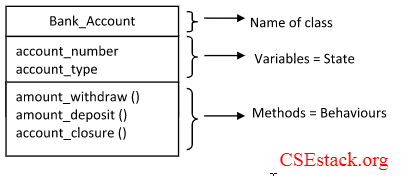Associate Architecture - jjin-choi/study_note GitHub Wiki
-
Object : An object represents an entity with a well-defined boundary and identity that encapsulates state and behavior.
- state : object 의 상태.
- represented by attributes and relationship.
- normally changes over time
- behavior : object 의 행위.
- represented by operation, method, and state machine.
- modeled by the set of messages which it can respond to.
- Objects need to collaborate
- each object is responsible for its own behavior and status.
- No one object can carry out every responsibility on its own.
- 모든 object 는 자기 자신의 behavior 과 status 에만 접근할 수 있기 때문에 object 간 소통하기 위해서는 collaboration, 즉 message passing 이 필요하다.
- state : object 의 상태.
-
Class : A class is a description of a set of objects that share the same state and behavior.
- An object is an instance of a class.
- Attribute : A named property of a class that describes a range of values which instances of the property may hold.
- Operation : the implementation of a service which can be requested from any object of the class to affect behavior.
-
Relationship between class and object : A class is an abstract definition of an object.
-
Objects are grouped into classes
-
An object is an instance of a class
-
Link: Object_Oriented
-
-
-
Message : A specification of a communication between objects.
- Conveying information with the expectation that activity will ensue.
- One object asks another object to perform an operation.
-
Quiz 01. Object 에 대한 다음의 설명 중 올바른 것은?
- object 는 state 와 behavior 중 하나를 가진다.
- object 의 state 는 시간이 지남에 따라 변하지 않는 상태를 의미한다.
- object 의 behavior 는 정확하게 하나의 operation 에 의해서 표현된다.
state 정보가 모두 같더라도 두 objects 는 다른 objects 이다.
-
Quiz 02. Class 에 대한 다음의 설명 중 올바르지 않은 것은?
-
Class 는 다양한 속성 (Properties) 을 갖는 a set of objects 을 하나로 묶어주는 description 이다.- 다양한 속성이 아니라 동일한 속성을 갖는다.
- Class 는 object 에 대한 abstract definition 이다.
- Object 는 class 의 한 instance 이다.
- Class 는 objects 을 생성 (creation) 하는데 사용하는 일종의 틀 (template) 이다.
-
-
Abstraction
- "Any model that includes the most important, essential or distinguishing aspects of something while suppressing or ignoring less important, immaterial, or diversionary details. The result of removing distinctions emphasize commonalities." - Dictionary of Object Technology
- Emphasizes relevant characteristics, but suppresses other characteristics.
-
Encapsulation
- "Design, produce and describe software so that it can be easily used without knowing the details of how it works"
- A.k.a. information hiding
-
Inheritance
- "is a kind of", "is a" relationship
- A way of organizing classes
- Also known as generalization
- Classes with properties in common can be grouped so that their common properties are only defined once.
-
Polymorphism
- The ability to hide many different implementation behind a single interface.
- The same word or phrase can mean different things in different contexts
- Example) In English, a bank can mean side of a river or a place to put money. 문맥 상 다른 의미로 해석
-
Composition
- Object composition : "has a" relationship between objects
- Defined dynamically at runtime by acquiring references to other objects.
- Does not break encapsulation, because objects are accessed solely through interfaces.
- Any compatible object can be replaced with another at runtime.
< 사진 추가하기 >
-
Procedural Programming
- Organized with procedures (statements changing value of variables)
- Focusing on data structures, algorithm, and sequences of step
- 알고리즘과 데이터 간의 dependency 가 없기 때문에 알고리즘을 어디에든 사용할 수 있음.
- SASD (Structured Analysis & Structured Design) : 구조적 분석 설계 방법론
- Top-down divide and conquer
- Data Flow Diagram (DFD) 사용
-
Object-Oriented Programming
- Organized with objects (data and operation)
- Object communications : No explicit data flow. only communication sequences among objects
- OOAD (OOA + OOD)
- Object-Oriented Analysis : discover the domain concepts/objects, identify requirements (use cases)
- Object-Oriented Design : define s/w objects (Static model), define how they collaborate to fulfill the requirements (dynamic models)
-
Software (Development) Process Model
-
Waterfall model : systematic & sequential approach
-
Iterative model
-
Agile development : rapid prototyping, development.
- iterative, incremental, actively involve users to establish requirements
-
Agile manifesto
- individual > processes and tools
- working s/w > documentation
- customer collaboration > contract negotiation
- responding to change > following a plan
-
Unified Process (UP) : iterative OOAD
- Risk driven (client, architecture)
- cycle : inception → elaboration → construction → transition
-
-
-
Quiz 01. OOAD 에 대한 설명 중 올바르지 않은 것은? → 다 맞는 말이긴 하지만, 정확히는 OOAD 는 개발 방법론은 아니다.
- OOP 을 위한 소프트웨어 개발 방법론 중 하나이다.
- OOA 는 Domain concepts/objects 를 찾는 단계이다.
- OOD 단계에서는 Software object 를 정의한다.
- OOD 에서는 object 가 서로 어떻게 collaboration 하는지를 정의한다.
-
Quiz 02. UP 기반 OOAD 방법론에 대한 설명 중 올바르지 않은 것은?
-
Iterative, Incremental 및 Evolutionary 한 소프트웨어 개발 방법론이다.
-
Risk-driven 하고 architecture-centric 한 개발 방법론이다.
-
Client 보다는 Architecture 관점에서 발생할 수 있는 risk 를 줄이는 것을 중요하게 생각한다.- 둘 다 동일하게 중요하다.
-
모든 단계에서 use cases 가 중요하게 사용된다.
- 모든 phase 에서 iterative mini waterfall 내에서 모두 use cases driven 함.
-
-
-



